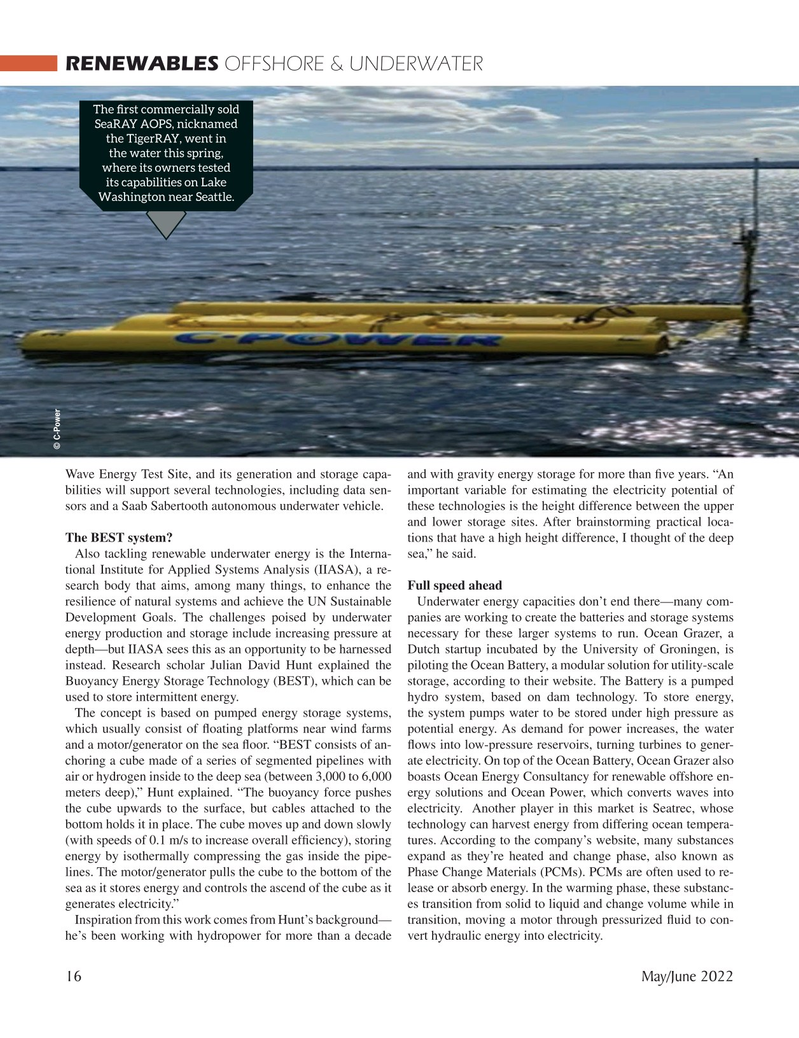
Page 16: of Marine Technology Magazine (May 2022)
Read this page in Pdf, Flash or Html5 edition of May 2022 Marine Technology Magazine
RENEWABLES OFFSHORE & UNDERWATER
The ? rst commercially sold
SeaRAY AOPS, nicknamed the TigerRAY, went in the water this spring, where its owners tested its capabilities on Lake
Washington near Seattle. © C-Power
Wave Energy Test Site, and its generation and storage capa- and with gravity energy storage for more than ? ve years. “An bilities will support several technologies, including data sen- important variable for estimating the electricity potential of sors and a Saab Sabertooth autonomous underwater vehicle. these technologies is the height difference between the upper and lower storage sites. After brainstorming practical loca-
The BEST system? tions that have a high height difference, I thought of the deep
Also tackling renewable underwater energy is the Interna- sea,” he said. tional Institute for Applied Systems Analysis (IIASA), a re- search body that aims, among many things, to enhance the Full speed ahead resilience of natural systems and achieve the UN Sustainable Underwater energy capacities don’t end there—many com-
Development Goals. The challenges poised by underwater panies are working to create the batteries and storage systems energy production and storage include increasing pressure at necessary for these larger systems to run. Ocean Grazer, a depth—but IIASA sees this as an opportunity to be harnessed Dutch startup incubated by the University of Groningen, is instead. Research scholar Julian David Hunt explained the piloting the Ocean Battery, a modular solution for utility-scale
Buoyancy Energy Storage Technology (BEST), which can be storage, according to their website. The Battery is a pumped used to store intermittent energy. hydro system, based on dam technology. To store energy,
The concept is based on pumped energy storage systems, the system pumps water to be stored under high pressure as which usually consist of ? oating platforms near wind farms potential energy. As demand for power increases, the water and a motor/generator on the sea ? oor. “BEST consists of an- ? ows into low-pressure reservoirs, turning turbines to gener- choring a cube made of a series of segmented pipelines with ate electricity. On top of the Ocean Battery, Ocean Grazer also air or hydrogen inside to the deep sea (between 3,000 to 6,000 boasts Ocean Energy Consultancy for renewable offshore en- meters deep),” Hunt explained. “The buoyancy force pushes ergy solutions and Ocean Power, which converts waves into the cube upwards to the surface, but cables attached to the electricity. Another player in this market is Seatrec, whose bottom holds it in place. The cube moves up and down slowly technology can harvest energy from differing ocean tempera- (with speeds of 0.1 m/s to increase overall ef? ciency), storing tures. According to the company’s website, many substances energy by isothermally compressing the gas inside the pipe- expand as they’re heated and change phase, also known as lines. The motor/generator pulls the cube to the bottom of the Phase Change Materials (PCMs). PCMs are often used to re- sea as it stores energy and controls the ascend of the cube as it lease or absorb energy. In the warming phase, these substanc- generates electricity.” es transition from solid to liquid and change volume while in
Inspiration from this work comes from Hunt’s background— transition, moving a motor through pressurized ? uid to con- he’s been working with hydropower for more than a decade vert hydraulic energy into electricity. 16 May/June 2022
MTR #4 (1-17).indd 16 4/28/2022 2:48:28 PM

 15
15

 17
17
